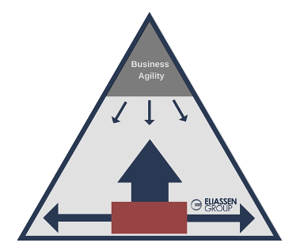Recently, Eliassen Group hosted our latest installment in our Agile Roundtable Series over breakfast at Fidelity Investments in Durham, NC. The topic this time was “Business Agility,” one that has seen a lot of press recently, including an article in the May 2016 Harvard Business Review entitled, “Embracing Agile.” The discussion was moderated by Tom Wessel, Enterprise Agile Coach for the Eliassen Group. Panelists included:
- Josh Brose, VP, Workplace Investing, Fidelity Investments;
- Rick Cobb, President and Co-Founder, AgileCraft; and
- Tom Mullen, Regional Agile Delivery Lead, Eliassen Group
The panel kicked off by attempting to frame the discussion with a definition of Business Agility. Business Agility is one of those emerging terms that has no industry standard definition and means a lot of different things to different people. There was definitely a consensus that a business must be Agile to survive in this day and age. As complexity and the rate of change continue to increase, the ability to identify what the most important initiatives or opportunities are and to respond in a timely, effective, and sustainable way is critical. Traditional top down, command and control, functionally silo-ed organizations are not built for today’s business environment. The key point, though, is that Business Agility is a state to be reached, not a method or process to employ.
Moving Agile Beyond IT
To date, Agile has predominantly been limited to the IT arena. Agile was coined by software developers and each of the myriad agile methods has grown out of the desire to create better, higher-quality software by improving how that process works. As the Agile movement tries to expand beyond IT, there is a wide chasm separating past success with software development and the adoption of Agile in the business as a whole. Part of that challenge is the fact that Agile is so closely tied to IT – another thing business types can leave to the techies downstairs. What the business side of the house needs to learn is that Agile is not a method or a process. It is not IT. It is a shift in mindset to a better way of working, with a focus on delivering value, delighting the customer, and engaging employees in meaningful, rewarding work. By focusing on the principles of Agile instead of the process, the business can begin to transform.
Your Journey to Business Agility
A few of the key shifts in thinking that the panel offered as places to start a journey to Business Agility included:
Focus on value – Business in general has been primarily concerned with creating shareholder value. This leads to a top-down structure where decisions can short-change customers, employees, and other stakeholders at the expense of ownership. An agile business instead focuses on customer value, understanding and optimizing their value streams so that quality product is delivered early and often. Reorganizing around products instead of functional silos is a huge step to making that possible.
Learn and Adapt – The agile mindset is one comfortable with not knowing. Being Agile means constantly testing assumptions, experimenting to learn what the customer really wants, and continually adjusting both the plan and how it is executed.
Build and coach great teams – The team is a foundation of the agile movement. Optimizing how teams perform is therefore paramount to having success. IT has had great success breaking down silos and improving communication and performance by bringing together cross-functional teams with all of the skills needed to complete the work. A key component of this success that is usually forgotten by the business is that coaching is a big part of how teams reach a level of sustainable performance. Team coaching is a new skillset businesses need to embrace.
Foster predictability – Many agile transformations, whether IT or organizational in nature, start with the idea of delivering faster, cheaper, and with fewer resources. If that is your approach, you have just started a process optimization, not an agile transformation. Increased velocity is part of the promise, but predictability is what you’re really aiming for. Knowing how much can be accomplished in a certain timeframe provides the ability to set expectations and deliver against them continually.
Business Agility is the next frontier for the Agile movement. It is simple to understand and communicate, but like any major change, it is very difficult to do consistently and well. Changing a corporate mindset and culture takes time and effort but is absolutely necessary to keep up with the times. As the pace of change quickens, if you are not keeping up, then everyone else is accelerating away from you. For more information, read Tom Wessel's business agility definition. And to act on what you've learned, read about Eliassen Group's approach to Agile consulting.


